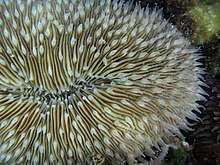Fungiidae
| Fungiidae | |
|---|---|
 | |
| Fungia scutaria | |
| Scientific classification | |
| Kingdom: | Animalia |
| Phylum: | Cnidaria |
| Class: | Anthozoa |
| Order: | Scleractinia |
| Suborder: | Fungiina |
| Family: | Fungiidae Dana, 1846 [1] |
| Genera | |
|
| |
The Fungiidae (/fəŋˈɡiːɪdi/) are a family of Cnidaria, often known as mushroom corals. The family contains thirteen extant genera. They range from solitary corals to colonial species. Some genera such as Cycloseris and Fungia are solitary organisms, Polyphyllia consists of a single organism with multiple mouths, and Ctenactis and Herpolitha might be considered as solitary organisms with multiple mouths or a colony of individuals, each with its separate mouth.[2]
Characteristics
| Wikinews has related news: Mushroom corals change from male to female and back again |
Species are generally solitary marine animals capable of benthic locomotion.[3][4] These corals often appear to be bleached or dead.[5] In most genera, a single polyp emerges from the center of the skeleton to feed at night. Most species remain fully detached from the substrate in adulthood. Some are immobile as well as colonial.[6][7]
Ecology
Some species of mushroom coral such as Fungia repanda and Ctenactis echinata are able to change sex. This is posited to take place in response to environmental or energetic constraints, and to improve the organism's evolutionary fitness; similar phenomena are observed in some dioecious plants.[8]
Genera
The World Register of Marine Species includes these genera in the family:[1]
- Cantharellus Hoeksema & Best, 1984
- Ctenactis Verrill, 1864
- Cycloseris Milne Edwards & Haime, 1849
- Danafungia Wells, 1966
- Fungia Lamarck, 1801
- Halomitra Dana, 1846
- Heliofungia Wells, 1966
- Herpolitha Eschscholtz, 1825
- Lithophyllon Rehberg, 1892
- Lobactis Verrill, 1864
- Pleuractis Verrill, 1864
- Podabacia Milne Edwards & Haime, 1849
- Polyphyllia Blainville, 1830
- Sandalolitha Quelch, 1884
- Sinuorota Oku, Naruse & Fukami, 2017
- Zoopilus Dana, 1846
Notable species
- One fungiid species, Heliofungia actiniformis ("anemone coral"), can be easily mistaken for a sea anemone [actiniarian] because its tentacles remain visible during the day.[6]
- Fungia spp. have a commensal pipefish, Siokunichthys nigrolineatus.[9]
- Heliofungia actiniformis provides shelter to some fish species (Gobiidae and Labridae).[10][11]
- Some fungiids can be elongated and look like a sea cucumber (stichopodid).
- Some fungiids (Danafungia scruposa) have been observed eating jellyfish.[12]
Importance to humans
Members of the family Fungiidae are not of any commercial importance, but are collected for the aquarium trade and are sold as "plate corals".
See also
References
- 1 2 WoRMS (2015). "Fungiidae: Dana, 1846". World Register of Marine Species. Retrieved 2018-07-25.
- ↑ Veron, J.E. (2013). "Colony formation". Corals of the World. Australian Institute of Marine Science. Retrieved 2015-04-22.
- ↑ Halstead, Bob. 2000. Coral Sea Reef Guide. Sea Challengers, Danville, CA, USA.
- ↑ "The Best Livestock For Your Reef Aquarium: Plate Corals, Family Fungiidae, Pt. 1". Wetwebmedia.com. Retrieved 2009-02-22.
- ↑ "Stony Corals From The Family Fungiidae, A.J. Nilsen, October 1997, Aquarium.Net". Reefs.org (Where Reefkeeping Begins on the Internet). Retrieved 2009-02-22.
- 1 2 "BioLib - Heliofungia actiniformis (Long tentacle plate coral)". Biolib.cz. Retrieved 2009-02-22.
- ↑ "Fungioidea". Tolweb.org. 2002-10-28. Retrieved 2009-02-22.
- ↑ Yossi Loya and Kazuhiko Sakai, "Bidirectional sex change in mushroom stony corals", Proceedings of the Royal Society B, 22 October 2008
- ↑ "Siokunichthys nigrolineatus". Fishbase. Retrieved 2009-02-22.
- ↑ Bos, Arthur R (2012). "Fishes (Gobiidae and Labridae) associated with the mushroom coral Heliofungia actiniformis (Scleractinia: Fungiidae) in the Philippines". Coral Reefs. 31: 133. doi:10.1007/s00338-011-0834-3.
- ↑ Bos AR, Hoeksema BW (2015). "Cryptobenthic fishes and co-inhabiting shrimps associated with the mushroom coral Heliofungia actiniformis (Fungiidae) in the Davao Gulf, Philippines". Environmental Biology of Fishes. 98 (6): 1479–1489. doi:10.1007/s10641-014-0374-0.
- ↑ "Predatory coral eats jellyfish". BBC News. 2009-11-13. Retrieved 2009-11-13.
Gallery
_(20_cm).png) Heliofungia sp. looks similar to a sea anemone.
Heliofungia sp. looks similar to a sea anemone.- Fungia sp. in Papua New Guinea
 Herpolitha limax in Micronesia can appear bleached and also resemble a sea cucumber.
Herpolitha limax in Micronesia can appear bleached and also resemble a sea cucumber. Fungia sp.
Fungia sp.
External links
| Wikispecies has information related to Fungiidae |
| Wikimedia Commons has media related to Fungiidae. |